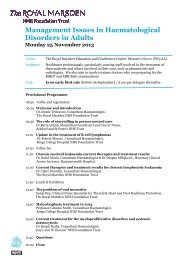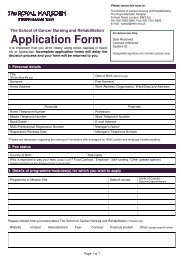Central Venous Access Devices - The Royal Marsden
Central Venous Access Devices - The Royal Marsden
Central Venous Access Devices - The Royal Marsden
You also want an ePaper? Increase the reach of your titles
YUMPU automatically turns print PDFs into web optimized ePapers that Google loves.
<strong>Central</strong> venous access devicesImplanted portsWhat is an implanted port?A portA port with special needleAn implanted port (sometimes called a ‘Portacath’) is a device,which is inserted under the skin into your body. <strong>The</strong> usual positionis on the chest. It can be placed on either side of your chest. <strong>The</strong>port is made up of a portal body and this is connected via a thintube (catheter) inserted into one of the body’s veins – see diagrambelow. <strong>The</strong> port can be felt through the skin. Entry to the port isgained by puncturing the silicone membrane with a special typeof needle, which is attached to a length of tubing (an extensionset). This will allow you to receive fluids and drugs or have bloodsamples taken from it. Puncturing the port is similar to prickingthe skin with a pin. Naturally it takes some getting used to. If it ispainful, we can apply local anaesthetic gel to the area 30 minutesbefore we insert the needle to numb the skin.What are the advantages of an implanted port?• It only needs to have the needle put in when we need to use it.• <strong>The</strong> needle is removed in between treatments and you will nothave to worry about any dressings or flushing the catheter.• It doesn’t restrict your normal activities including swimming.What are the disadvantages of an implanted port?• You still need to have a needle inserted each time the port isused. <strong>The</strong> port can sometimes be difficult to access.15
















